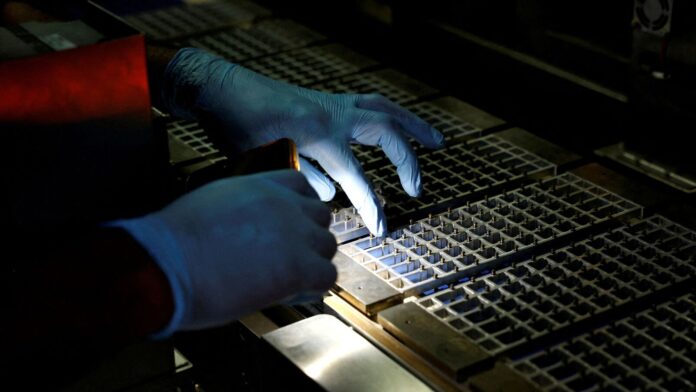The plan seeks to lift the share of manufacturing in GDP to 25% by 2035 from around 13% now, while aligning with a proposed US-India trade deal expected to ease tariff barriers. The US had earlier slapped a 50% tariff on Indian goods as a penalty for importing Russian crude oil and allegedly funding the Russia-Ukraine war.
However, Mint reported on 22 October, an India-US trade deal is close to being finalised, and will likely reduce tariffs to about 15-16% from the earlier 50% levy. The move would make Indian exports more competitive with other Asian economies such as Japan (15% tariff), Vietnam (20%), and Indonesia (19%).
The broader intent of the mission, announced in the FY26 Union Budget, is to position India more effectively within global value chains and increase its contribution to global manufacturing output.
An inter-ministerial committee comprising NITI Aayog, department of promotion of industry and internal trade (DPIIT), and the ministries of electronics, steel, heavy industries, and renewable energy, among others, has proposed viability gap funding (VGF) to spur investment in priority sectors and niche manufacturing areas, according to the draft proposal reviewed by Mint.
According to the proposal, the NMM will provide strategic oversight to the country’s manufacturing ecosystem — setting clear output and export targets and ensuring ministries stay aligned. Importantly, the mission will not alter the mandates of existing departments but will act as a coordinating body.
The NMM aims to boost India’s 66 million micro, small, and medium enterprises (MSMEs) and strengthen competitiveness across small, medium, and large industries under the ‘Make in India’ initiative. Finance minister Nirmala Sitharaman had said the mission will provide policy support, execution roadmaps, and a governance framework for central ministries and states to improve domestic value addition in emerging sectors such as solar PV cells, electric vehicle (EV) batteries, motors and controllers, electrolyzers, wind turbines, high-voltage transmission equipment, and grid-scale batteries.
The NMM was originally allocated ₹100 crore, according to a Press Information Bureau (PIB) factsheet dated 15 August.
Seven-region focus
To make India’s industrial push more granular, the government plans to map and monitor manufacturing across seven regional clusters, each with distinct strengths.
- Southwest (in and around Bengaluru and Chennai): high-tech sectors such as semiconductors and aerospace.
- Northwest (Delhi-NCR, Punjab, Haryana): food products, consumer durables, and EVs.
- North Central (Agra, Prayagraj): automotive spare parts, leather, and non-metallic products.
- Northeast (Arunachal Pradesh, Assam, Manipur, Meghalaya, Mizoram, Nagaland, Sikkim, and Tripura): pharmaceuticals and botanical products.
- West (Gujarat, Maharashtra): capital goods, electronics, and pharma.
- East (West Bengal): basic metals including iron and steel.
- South (Tiruppur, Hosur): automotive components, capital goods, and electronics.
Email queries to DPIIT, ministry of electronics and IT, ministry of heavy industries, ministry of new and renewable energy, ministry of steel and to the NITI Aayog sent on 22 October remained unanswered till press time.
Cluster advantage
Experts say the cluster-based approach is crucial to cutting costs and boosting competitiveness.
“India has few clusters like Tirupur for garments and Ludhiana for cycles which have been successful, that too with a global footprint. Clusters should be set up in a way that the required raw materials are available within or nearby the cluster or such raw materials makers are invited to set up their plants within that cluster,” said Vinod Kumar, president, India SME Forum.
“Further, infrastructure like ports and transport should be easy to access given the export requirement. All machinery, quality testing and IP (Intellectual Property) formalities should be carried out within the cluster, offering enterprises ease of doing business,” Kumar added.
Key Takeaways
- The National Manufacturing Mission aims to significantly increase India’s manufacturing GDP contribution.
- Cluster-based approaches can enhance competitiveness and reduce costs for manufacturers.
- Global partnerships for technology and knowledge sharing are essential for long-term success.
For long-term success, experts emphasize the importance of technology partnerships and quality standards.
Amit Kumar, partner and climate ecosystem leader at Grant Thornton Bharat stressed the need for global partnerships for technology transfer and knowledge sharing and a focus on the international market apart from catering to the domestic demand.
“Enterprises, including smaller businesses need to eye the global market and focus on quality of the products. Further, as in countries like Germany, global tie-ups for technology and knowhow by Indian businesses would go a long way to boost manufacturing in India,” Kumar of Grant Thornton Bharat said.
According to World Bank data cited in the draft proposal, India’s share in global manufacturing output is 2.9%, compared with China’s 31.6%. The proposal noted that this low contribution partly reflects the faster growth of India’s services sector, but also the manufacturing sector’s own underperformance.
By identifying 15 key sectors and strengthening 66 million MSMEs, the NMM seeks to close this gap, enhance domestic value addition, and embed India more deeply into global value chains.
India National Manufacturing Mission,US-India trade deal,manufacturing GDP share,greenfield projects,National Manufacturing Mission,manufacturing sector,India GDP,NITI Aayog,MSMEs India,Make in India,trade deal,trade tariffs,semiconductors
#India #plans #10000crore #push #reboot #manufacturing #mission

